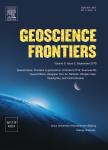Mapping favorable groundwater potential recharge zones using a GIS-based analytical hierarchical process and probability frequency ratio model:A case study from an agro-urban region of Pakistan
Mapping favorable groundwater potential recharge zones using a GIS-based analytical hierarchical process and probability frequency ratio model:A case study from an agro-urban region of Pakistan作者机构:Key Laboratory of Digital Earth ScienceInstitute of Remote Sensing and Digital EarthChinese Academy of SciencesBeijing 100049China University of Chinese Academy of SciencesBeijing 100049China Department of GeographyCenter for Environmental Sciences and Engineering(CESE)University of ConnecticutStorrsCT06269-4148USA LREISInstitute of Geographic Sciences and Natural Resources ResearchChinese Academy of Sciences11ADatun RoadChaoyang DistrictBeijing 100101China
出 版 物:《Geoscience Frontiers》 (地学前缘(英文版))
年 卷 期:2020年第11卷第5期
页 面:1805-1819页
核心收录:
学科分类:081603[工学-地图制图学与地理信息工程] 081802[工学-地球探测与信息技术] 081803[工学-地质工程] 07[理学] 08[工学] 0708[理学-地球物理学] 070503[理学-地图学与地理信息系统] 0818[工学-地质资源与地质工程] 0705[理学-地理学] 0816[工学-测绘科学与技术] 0704[理学-天文学]
主 题:Weightage overlay Analytical hierarchical process(AHP)analysis Frequency ratio(FR) Vulnerability Groundwater recharge zones Area under curve(AUC)
摘 要:In Punjab(Pakistan),the increasing population and expansion of land use for agriculture have severely exploited the regional groundwater *** pumping has resulted in a rapid decline in the level of the water table as well as its *** management practices and artificial recharge are needed for the development of sustainable groundwater *** study proposes a methodology to delineate favorable groundwater potential recharge zones(FPRI)by integrating maps of groundwater potential recharge index(PRI)with the DRASTIC-based groundwater vulnerability index(VI).In order to evaluate both indexes,different thematic layers corresponding to each index were overlaid in *** the overlay analysis,the weights(for various thematic layers)and rating values(for sub-classes)were allocated based on a review of published *** were then normalized and modified using the analytical hierarchical process(AHP)and a frequency ratio model *** evaluating PRI and FPRI,these maps were validated using the area under the curve(AUC)*** PRI map indicates that 53%of the area assessed exists in very low to low recharge zones,22%in moderate,and 25%in high to excellent potential recharge *** VI map indicates that 38%of the area assessed exists in very low to low vulnerability,33%in moderate,and 29%in high to very high vulnerability *** FPRI map shows that the central region of Punjab is moderately-to-highly favorable for recharge due to its low vulnerability and high recharge *** the validation process,it was found that the AUC estimated with modified weights and rating values was 79%and 67%,for PRI and VI indexes,*** AUC was less when evaluated using original weights and rating values taken from published *** of favorable groundwater potential recharge zones are helpful for planning and implementation of wells and hydraulic structures in this region.



